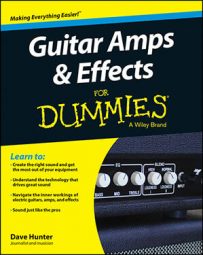Your guitar’s fingerboard is one place where grime can often build up, even if you regularly wipe down your instrument each time you play it. The sweat and oils from your fingers gather along fret edges and in the wood grain where a cleaning cloth may ordinarily miss it if the strings are in the way.
Give the fingerboard a real deep-cleaning when you change strings, and take them all off the guitar at once. You may only do this only once every six months, or maybe once a year, depending on how much you play the guitar in question.
If your guitar has a floating or tip-up vibrato unit, one where the base is normally raised slightly off the top of the body by the balance of string-and-spring tension, put something firm between the base and body to keep the bridge in position. (A stack of business cards works well, because you can easily adjust to the correct height by using more or fewer cards.)
If you have the kind of bridge that comes off entirely when string pressure is removed, such as a non-locking tune-o-matic and stopbar tailpiece, or a floating bridge, you can secure it in position with a little painter’s tape (the type that won’t damage paint or finish when it’s pulled off after).
With the strings off the guitar, first spray a little standard guitar cleaner/polish on the fingerboard — bracing its neck against something firm but soft so you don’t damage the neck joint with any cleaning pressure — and rub firmly with a cleaning cloth.
Next, if you have a long enough thumb or fingernail, wrap a little of a clean cotton rag (an old t-shirt is perfect) around the nail and run it gently but firmly along each edge of each fret, where the fret meets the wood of the fingerboard.
![[Credit: Photograph by Dave Hunter]](https://www.dummies.com/wp-content/uploads/444628.image0.jpg)
This inevitably brings out a stripe of grime on the cloth, which shows that you’re getting the job done. (If your nails aren’t long enough, you can wrap the cleaning cloth around the point of a guitar pick, or the corner of a credit card — something firm but not stiff enough to scratch or gouge your fingerboard.)
After you’ve de-grimed each side of each fret all the way up the neck, spray just a little cleaner on another clean cloth and wipe down the entire fingerboard to remove any dirt and particles that were dislodged in the process.
Chances are you might need to throw out the rag that you used for the fret-edge deep cleaning, because it will probably now be laced with grime stripes that you don’t want to rub back into your guitar, and the cleaning solution is often difficult to wash out (if you’re using recycled cotton t-shirt rags anyway, it usually isn’t too great a loss!).

